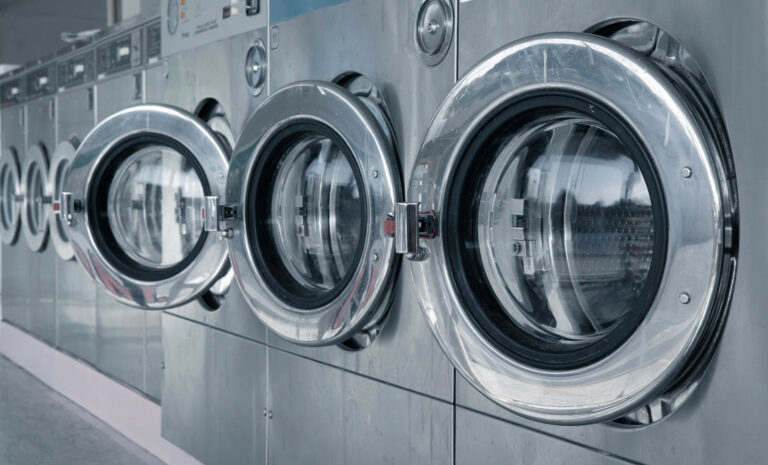Why Professional Car Washes are Better Than Washing At Home
Everyone needs their clothes cleaned, yet doing laundry is one of those routine tasks that is both an unavoidable necessity and a tedious chore that is far too easy to procrastinate. Nobody wants to spend their free time sorting through their dirty socks, dragging gargantuan mounds of clothing to the washing machine, and washing and drying load after load only to realize that you still have to re-sort, fold, and put away every item you just cleaned. And for some of us, the “privilege” of doing laundry where we live isn’t even an option; life without a laundry machine in the comfort of your own home can be an entirely different struggle.
Even if you do have a washer and dryer at home, there are many benefits to doing laundry at a laundromat, and many tips to maximize those benefits. Read on to discover how using a laundromat can actually be the superior choice for your wallet, your schedule, and your sanity.
Benefits of Laundromats
While you can’t get around doing laundry, you can make the task much more enjoyable by going to a laundromat. There are actually numerous benefits to using the machines at a laundromat that many folks aren’t aware of – even those that use them regularly. You can in fact save both time and money by choosing to do you laundry outside of your home and at your local laundromat.
1. One Load Cleans All Laundry
On average, a family does between 8 and 10 loads of laundry every week. With only one washer and one dryer, getting through all that laundry at home can take hours. There is also a lot more temptation to overload the machines and you end up either having to redo the whole load or deal with damp and dirty clothes.
However, at a self-service laundromat, you are able to load and run multiple washers and dryers at the same time. This allows you to take care of all your laundry in one fell swoop, meaning the time invested is significantly less.

2. The Washers and Dryers are Larger
Most residential sized washers and dryers are sufficient for cleaning normal clothes, but they often are too small to wash comforters, blankets, coats and other large items. Even when there is technically enough space to fit those larger items, there may not be enough room for the items to move around freely, preventing them from being thoroughly cleaned and also drying properly.
The average household washing machine is able to hold around 15 pounds of laundry, at most; however, the commercial machines at your local laundromat are often able to hold up to 75 pounds of laundry at a time. Laundromats that have washing machines and dryers with a higher capacity allow enough space for larger items. Their high-capacity washers and dryers can also reduce the number of loads you need to do, even for regular clothes. You can put more items – big and small – in the machine, and therefore get it all done more efficiently.
3. You Get Cleaner Clothes
When clothes are crammed too close together in a washing machine, they won’t be as effectively cleaned as they would if they were washed in smaller loads, or if they were washed in larger washers. The extra room is so important because it makes it easier for soap to penetrate into all parts of the load to remove all the dirt and grime that builds up in the fabrics. The larger washing machines at laundromats provide you with more space for each of your loads, which makes it much simpler for the machine to actually do its job and clean your laundry properly without leaving you stuck needing to cut down on the amount of laundry you can do in a single load.
4. You Cut Your Bills and Protect the Planet
A standard home washing machine uses between 30 and 40 gallons of water per load – 33 gallons on average; however, older models can use up to 45 gallons per load or more. If you do 10 loads of laundry every week, that’s anywhere from 300 to 450 gallons of water just on laundry. That’s a big water bill. You also end up burning a lot of electricity powering your washing machine and dryer. Between water and electricity, washing laundry at home can increase your utility bills drastically.
One way to solve this problem may be to get an Energy Star Label washer.
“Energy-efficient clothes washers use advanced technology, but in some models, longer wash cycle times save on utility and water costs. Advanced technology improves water and power usage in both types of washing machines, top- and front-loading,” says the SF Gate Home Guide. “Energy Star rated models use between 10 and 20 gallons of water per load, based on the machine type. Most Energy Star models also have cycles that can match the size of the washer load, which saves energy and water.”
Although buying your own highly efficient Energy Star Label is one route, most laundromats have similar machines already. Commercial washers are designed to be significantly more efficient than home washing machines. They use as little as 0.5 to 1.5 gallons of water per pound of clothes, compared to the 2.5 to 3.0 gallons of water per pound of clothes used in an ordinary home washing machine.
When you use a laundromat – whether self-service or full service – you cut down on your water and energy consumption at home and you’ll likely notice a drop in your bills if you make the switch. Better yet, the reduced water and energy consumption is much more eco-friendly and doesn’t waste valuable water. So, it’s a win for your wallet and the environment!
“If you want to reduce your carbon footprint at the laundromat, opt for a front-loading washer instead of a top loader because it uses 50 percent less water,” writes Mary Marlowe Leverette in an article for The Spruce on the topic. “Always wash a full load (you’ll save money that way, too), choose a bio-based (plant based) laundry detergent, and use cold water as much as possible.”
5. The Cost is Lower
Beyond cutting your water and energy bills, doing your laundry at a laundromat can save money overall. Sure, it costs some money, but it’s probably more affordable than you would think at first glance – and the utility bill reduction is only a small part of it.
You can also save on the machine itself. If you do all your laundry at your local laundromat, you don’t need to buy an expensive washing machine and dryer for your home.
The math checks out: whereas a trip to the laundromat costs a few dollars, purchasing a washing machine can cost anywhere from $250 to more than $2000, and dryers typically range from $200 to $1,750. Even in the best-case scenario where a laundromat is highly expensive per trip and a washing machine and dryer are very cheap, it can take years for the investment to “pay off.” And that’s assuming you don’t have to repair the machines yourself. Washing machine repairs average $100 to $350 or more, and dryer repairs average $100 to $430. Cheaper or older machines tend to break down more, too.
The fact is, a laundromat gives you unparalleled access to commercial-quality machines with lots of great features for a low price.
6. You Can Save Time
Laundromats save time for most people who make the switch. Why? Here are just a few of the reasons:
- Hours of Operation: One of the major benefits of laundromats is that many are open 24/7, so you won’t bother family members or roommates if you do your laundry late at night. If you work an atypical schedule, that leaves you doing your laundry in the early morning or late night, a 24/7 laundromat especially helpful. You can even swing by after work to do your laundry and then go home knowing it’s taken care of.
- Running Errands: Of course, washing your clothes at a laundromat doesn’t have to take up all of your time, and it shouldn’t. You can load your laundry and then take off to do something else while you wait for it to finish. Some people prefer the peace of sitting and relaxing while their clothes go through the wash and dry process, so they might bring along a book to read for entertainment or even a laptop to do some quick work while they wait. Others like to take the time to run errands like getting groceries, picking up dry cleaning, visiting the bank, or doing whatever other chores they want to cross off their daily list. It is always great to only have to go out once to get all your errands done.
- Multiple Machines: Laundromats are equipped with row upon row of washers and dryers, which is a major advantage compared to the one of each the average home has. This means that you can usually wash and dry your clothes all at the same time without needing to add on 30 minutes to an hour or more for every additional load you do. When you do laundry at the laundromat with the ability to pack more clothes into a single machine, this also helps cut down on the amount of time you spend doing laundry.
- Doing it Right: The old saying “Do it right the first time, and you won’t have to do it a second time” is especially true with laundry. If it gets properly washed and fully dried, there is no need to redo anything. While at-home machines can be easily overfilled, rendering them less effective, the higher load capacity and superior efficiency of commercial washing machines and dryers makes them more likely to do your laundry right the first time.
Tips for Using a Laundromat
Like most things in the world, doing laundry tends to go a little bit more smoothly when you’re prepared. As such, you may want to take a few minutes to make sure that you are completely ready to do your laundry before you head out to the laundromat.
1. Prepare, Prepare, Prepare!
There are few things more irritating than when you load all of your dirty clothes into a washing machine, only to discover that you left your detergent at home. Here is a useful checklist of questions to ask yourself before you head to the laundromat:
- Have you packed your laundry detergent, fabric softener, and/or bleach? Spills can be a nightmare – is the bleach properly sealed with the cap screwed tightly on, or better yet encased in a plastic Ziploc bag?
- Have you packed dryer sheets?
- Do you have clean laundry bags or your hamper?
- Do you have clothes hangers?
- Do you have small bills or coins for payment? If not, are you positive that you can pay with an app or with your credit or debit card?
- Do you have entertainment (such as a book, your phone and its charger, a laptop computer, etc.) or something else to do (like running errands) while you wait for your laundry to finish?
- Have you emptied your pants pockets? You never know when you might find a little extra cash, or even your earbuds – saving yourself from a major disaster.
- Have you pre-sorted through your laundry?
All of these tips will save you time and stress, but none more so than pre-sorting your laundry. Pre-sorting your laundry before you go to the laundromat is a smart, time saving move!
2. Sort Your Laundry Properly
When you sort your laundry correctly, it not only prevents accidents, but also aids in cleaning, preserves colors, reduces drying time, and diminishes the wear and tear on certain types of clothes. Another major bonus to pre-sorting is that once you arrive at the laundromat, you can quickly get your clothes into the available washing machines and begin the cycle, helping you get home quicker. If you want to take it a step further, you can even start pre-measuring the detergents for each load.
3. Read the Label
Before washing any item, be sure to carefully read its label. There you’ll find important information on how to clean the item. The label will tell you the recommended water temperature and drying temperature to clean the item properly, making it last for years.
4. Sort Blended Fabrics
Sorting blended fabrics can be a bit of a challenge, since it’s difficult to decide how to categorize them. “Our rule of thumb for washing a blend is to follow the instructions for the fabric with the highest percentage,” writes The Laundress in a blog post on the topic. “For example, if the label indicates that a shirt contains a blend of 70% cotton and 30% polyester, follow our washing instructions for cotton.”
However, there are more specific rules than that, according to the same article: “If the item contains any amount of silk, follow the washing instructions for silk even if the silk percentage is small. The same rule applies to all woolens and cashmere. If an item contains both silk and wool, follow the washing instructions for wool.”
5. Separate by Function
Here are some simple, yet effective ways to separate/group your laundry:
- Everyday laundry (this includes items that are mostly cotton or linen, and items such as T-shirts, khakis, button-down shirts, underwear, and socks) and durable synthetics
- Denim items
- Sheets, towels, and other bed and bath items
- Delicates, such as silk and silk-like fabrics, lingerie, and embellished items
- “Performance” fabrics, such as swimwear and activewear
- Woolens
- Items that are highly stained, dingy, or stinky
- Items labeled “Dry Clean” or “Dry Clean Only”
6. Color Code Items
You can take it a step further by sort your laundry by color. Separate each pile into smaller piles of colored, dark, and light or white items. For patterned items (such as stripes, plaids, polka dots, and florals), sort based on the dominant color. If no single color is dominant, take your pick of piles after sorting and wash those separately or group back together as you see fit.
7. Pretreat Stained Items
To pre-treat stained items, ammonia is often the best choice. However, you should be cautious about what you wash with ammonia; silk and wool, for instance, contain proteins that ammonia will eat through.
You can make an all-purpose stain remover by combining equal parts water, ammonia and liquid dish detergent (or your regular laundry detergent) in a spray bottle. You can spray this solution on food spills, ink stains, light grass stains and other marks at least 30 minutes before rinsing the solution out and laundering.
For a gentler version that doesn’t need to be rinsed out, “combine 1/2 ounce of ammonia with 1 ounce of detergent and 2 cups of water,” according to an article on The Hunker covering stain removal. “This contains less soap, so it is less effective, but perfect for minor discolorations.”
“Tackle blood, grass and urine stains by combining equal parts ammonia and water,” the article reads. “Apply the solution to the mark with a soft cloth or sponge and wait about 30 minutes before laundering per usual.”
If this ammonia solution is not appropriate for the stain on the fabric, there are plenty of stain pre-treatment and stain removal products that you can use, available at most stores that sell other laundry products.
Once you have treated any stains, wash each pile according to fabric type. If you are unsure of how to best clean a fabric, don’t forget that you can always look it up for more details. Be sure to learn the best and safest way to care for it, step by step, because you don’t want to waste money by damaging your clothes.
8. Check the Machine
Just as things can be left behind in your pants pockets, other laundry-goers can sometimes leave their own items behind. Always check inside each washing machine and dryer thoroughly before placing your items in it.
9. Customize the Clean
Of course, not everything needs a deep clean. If you’re washing lightly soiled everyday clothes, then sometimes a brief and simple wash is all you need. Over-washing can cause excess wear and tear on your clothes, waste water, and waste money. Choose the appropriate wash cycle and any added features needed for each specific load.
10. Pick a Good Detergent
One of the most important things when doing laundry is choosing a good detergent. Picking the right detergent helps the washing machine do its job. However, this is something that you shouldn’t rely on brand loyalty to decide, though.
“Many consumers are as loyal to their laundry detergent as they are to their favorite soft drink,” writes Mary Marlowe Leverette in an article for The Spruce on the topic. “Some just buy what their mother used and others buy what’s on sale. With so many choices on the market, you’re sure to find a laundry detergent that fits your budget and meets your laundry cleaning needs as well as your family’s preference of fragrance and environmental responsibility.”
According to a 2016 study, consumers in Europe were most concerned about the ability of a detergent to remove stains and keep colors bright. When it comes to removing stains, it may be prudent to consider the different types of detergent available. These include general purpose laundry detergents in liquid, powder, and single-use formulations.
- Liquid Detergents
All forms of laundry detergent can clean clothes well, but liquid detergents are particularly good for greasy, oily stains, and they are the easiest to use in the pretreatment of stains. The most common problem with liquid detergent is using too much per load (called “overdosing”). When you us too much detergent, you can end up wasting a lot of money and leaving detergent residue on your clothes.
- Powder Detergents
Powder detergents are usually less expensive per load, and more effective on mud stains and dirt that has become ground into the clothing. Powdered detergents can be problematic with cold water since they may not completely dissolve, especially if the water is extremely cold.
- Single-use Packs
Single-use packs are the most convenient to use – especially if you use a communal laundry room or laundromat – but they are also the most expensive to use per load. They may even take two packs to handle clothes that are especially dirty, or to handle larger loads. Single-use packs are pre-measured for an average soil and size load, so if you do large loads of laundry or heavily soiled laundry, you may find that one pack isn’t enough. Taking a look at your family’s needs will help you make a decision about whether you would benefit from using single-use products.
Nowadays, liquids, powders, and single packs are all usable at most water temperatures. Almost all brands are also now formulated for use in high efficiency or standard washers, but check for the HE (High Efficiency) symbol to be sure. Liquid and powder types are available in concentrated or “ultra” forms, so you should always read the labels to make sure you are using the correct amount of detergent per load.
11. Get the App
Many laundromats now have smartphone and other mobile device applications that can help you find a laundromat, translate care labels, and even treat stains with helpful tips. Also, you may be able to find discounts or promotions on these app. They may also have a laundry timer that allows you to run errands or focus on something besides laundry while your clothes are washing. The point is, if you download the app, you many get added benefits and perks.
12. Pick Your Laundromat Wisely
The best thing you can do to ensure your laundromat visit goes well is to simply visit a good laundromat. Not all laundromats are created equal. Choosing a clean and inviting place with new, modern machines will make your experience more enjoyable and also ensures your laundry gets a proper wash. It will also give you access to laundromat amenities that will make laundry day easier and more relaxed. Most importantly, it will give you a clean, sanitary experience, making laundry day a fun day.
If you’re looking for a laundromat in the Lancaster County area that meets all these qualifications and more, check out Sundance Laundry for a location near you!





